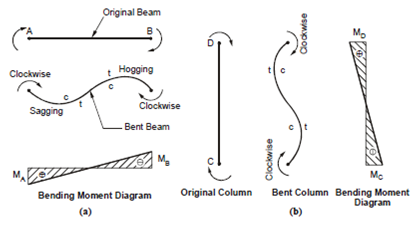Sign Conventions And Other Preliminaries:
Moment Distribution
The moment distribution method requires a sign convention which must be clearly defined. As equilibrium of joint moments is to be considered, we assume all clockwise moments as positive (and therefore anticlockwise moments as negative). Now with reference to bending of a member it will have a different meaning depending upon the end at which it is applied. For example, in Figure 3(a), a clockwise moment applied to the left hand end A of the member AB produces a sagging (or positive) bending moment. The same clockwise moment when applied to the right hand end B produces a hogging (or negative) bending moment. Opposite effects will be produced through anticlockwise moments.

Similarly, on a vertical member CD a clockwise moment at the lower end C produces tension on the right hand face (compression on left hand face) marked't' and 'c' correspondingly. A same clockwise moment at the upper end will produce tension on the left hand face (and compression on the right hand face). So the sign of the bending moments at the ends C and D will be opposite although the moments are both clockwise in direction. They may not be called hogging or sagging now. A best way to display their signs are to draw the positive bending moment on the tension side of the original axis line as shown above at Figures (a) and (b). Similarly, in moment distribution notation all joint rotations or chord rotation is positive if clockwise and negative if anticlockwise.